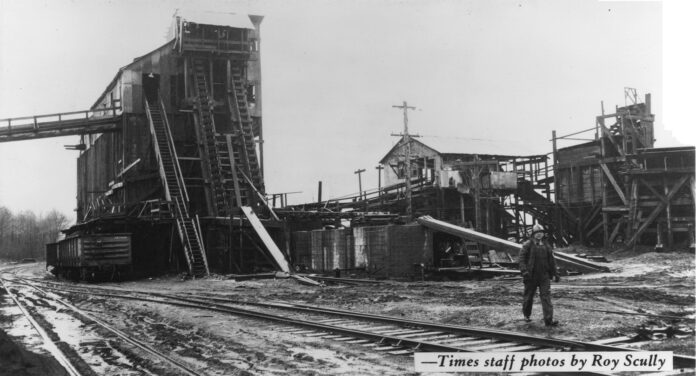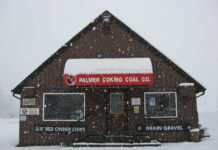In March 1927, after 31 years of production and 6.3 million tons of extracted coal, the mine that made Black Diamond famous closed for good. Still, Mine 11, or at least the name lived on for another seven decades as a center for coal processing and shipping. Though the underground workings were sealed shut, the extensive surface coal facilities remained. There were bins and bunkers for storing coal, plus warehouses, water lines, and high-voltage electricity. A railroad ‘wye’ or ‘Y’ allowed engines to turn around and spur tracks provided sidings for storing empty cars. There was also a washhouse where miners changed and showered.
The mine’s surface facilities were owned by Pacific Coast Coal Company. Between 1927 and 1944, two different wash plants occupied the site. Coal mined from nearby openings was transported there for processing and shipping.
In 1945, a new McNally-Norton wash plant was installed at Mine 11 and operated for the next 45 years. The plant was used to separate waste shale and rock from marketable coal. This 1953 photo by Ray Scully shows that plant to the right of the tall wood bunkers where coal was stored. To the left, an empty rail car is ready to be loaded with stoker coal. The plant was updated several times through the years.
In 1947, Palmer Coking Coal Company leased Pacific Coast Coal’s Mine 11 preparation plant and railroad facilities to further expand their market share. Palmer was the second-largest producer in King County and soon would be the biggest. By 1958, Palmer had acquired most of Pacific Coast Company’s land and mineral assets in King County.
Palmer’s acquisition of the McNally-Norton plant came with a significant benefit – Frank Manowski, its chief operator for 32 years. The wash plant’s final act was washing coal from the John Henry No. 1 surface mine. In 1990, it was mostly dismantled, and the surrounding area reclaimed. After 95 years of continuous operations, the coal-related functions of Mine 11 were finally exhausted. Today, all that remains is the large metal wash tub, some concrete tanks, and the name. Even today, some still refer to the historic yard located at 31407 Highway 169 as Mine 11.
The Summer 2024 issue of the Black Diamond Historical Society newsletter contains a detailed description of Mine 11 which opened in 1896. This is the fifth article in a series about Black Diamond’s coal mines. The Museum located at 32627 Railroad Avenue displays a wide variety of photos, murals, and artifacts that beautifully illustrate the town’s history. The Museum is open Thursday, 9 a.m. to 3 p.m. and Saturday-Sunday, 11 a.m. to 3 p.m. And check out their website at www.BlackDiamondMuseum.org, where you can sign up to become a member and receive educational newsletters.







